Related Research Articles
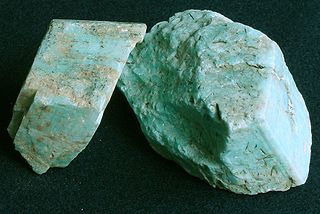
Amazonite, also known as amazonstone, is a green tectosilicate mineral, a variety of the potassium feldspar called microcline. Its chemical formula is KAlSi3O8, which is polymorphic to orthoclase.
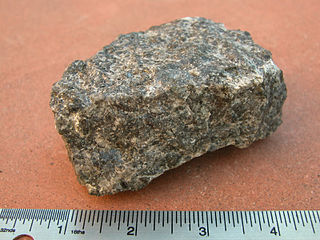
Gabbro is a phaneritic (coarse-grained), mafic intrusive igneous rock formed from the slow cooling of magnesium-rich and iron-rich magma into a holocrystalline mass deep beneath the Earth's surface. Slow-cooling, coarse-grained gabbro is chemically equivalent to rapid-cooling, fine-grained basalt. Much of the Earth's oceanic crust is made of gabbro, formed at mid-ocean ridges. Gabbro is also found as plutons associated with continental volcanism. Due to its variant nature, the term gabbro may be applied loosely to a wide range of intrusive rocks, many of which are merely "gabbroic". By rough analogy, gabbro is to basalt as granite is to rhyolite.

In geology and mineralogy, a mineral or mineral species is, broadly speaking, a solid substance with a fairly well-defined chemical composition and a specific crystal structure that occurs naturally in pure form.

Mineralogy is a subject of geology specializing in the scientific study of the chemistry, crystal structure, and physical properties of minerals and mineralized artifacts. Specific studies within mineralogy include the processes of mineral origin and formation, classification of minerals, their geographical distribution, as well as their utilization.
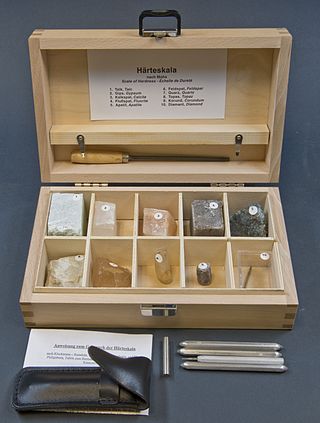
The Mohs scale of mineral hardness is a qualitative ordinal scale, from 1 to 10, characterizing scratch resistance of minerals through the ability of harder material to scratch softer material.

A mafic mineral or rock is a silicate mineral or igneous rock rich in magnesium and iron. Most mafic minerals are dark in color, and common rock-forming mafic minerals include olivine, pyroxene, amphibole, and biotite. Common mafic rocks include basalt, diabase and gabbro. Mafic rocks often also contain calcium-rich varieties of plagioclase feldspar. Mafic materials can also be described as ferromagnesian.

Sandstone is a clastic sedimentary rock composed mainly of sand-sized silicate grains, cemented together by another mineral. Sandstones comprise about 20–25% of all sedimentary rocks.

Feldspar is a group of rock-forming aluminium tectosilicate minerals, also containing other cations such as sodium, calcium, potassium, or barium. The most common members of the feldspar group are the plagioclase (sodium-calcium) feldspars and the alkali (potassium-sodium) feldspars. Feldspars make up about 60% of the Earth's crust and 41% of the Earth's continental crust by weight.
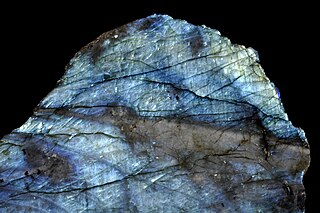
Labradorite ((Ca, Na)(Al, Si)4O8) is a calcium-enriched feldspar mineral first identified in Labrador, Canada, which can display an iridescent effect (schiller).

Coesite is a form (polymorph) of silicon dioxide (SiO2) that is formed when very high pressure (2–3 gigapascals), and moderately high temperature (700 °C, 1,300 °F), are applied to quartz. Coesite was first synthesized by Loring Coes, Jr., a chemist at the Norton Company, in 1953.
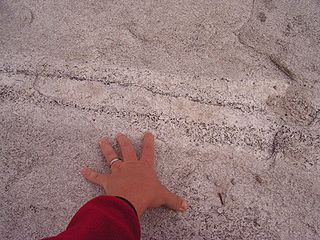
Metasomatism is the chemical alteration of a rock by hydrothermal and other fluids. It is traditionally defined as metamorphism which involves a change in the chemical composition, excluding volatile components. It is the replacement of one rock by another of different mineralogical and chemical composition. The minerals which compose the rocks are dissolved and new mineral formations are deposited in their place. Dissolution and deposition occur simultaneously and the rock remains solid.

Lamprophyres are uncommon, small-volume ultrapotassic igneous rocks primarily occurring as dikes, lopoliths, laccoliths, stocks, and small intrusions. They are alkaline silica-undersaturated mafic or ultramafic rocks with high magnesium oxide, >3% potassium oxide, high sodium oxide, and high nickel and chromium.

A QAPF diagram is a doubled-triangle plot diagram used to classify intrusive igneous rocks based on their mineralogy. The acronym QAPF stands for "Quartz, Alkali feldspar, Plagioclase, Feldspathoid (Foid)", which are the four mineral groups used for classification in a QAPF diagram. The percentages (ratios) of the Q, A, P and F groups are normalized, i.e., recalculated so that their sum is 100%.
Founded in 1958, the International Mineralogical Association (IMA) is an international group of 40 national societies. The goal is to promote the science of mineralogy and to standardize the nomenclature of the 5000 plus known mineral species. The IMA is affiliated with the International Union of Geological Sciences (IUGS).
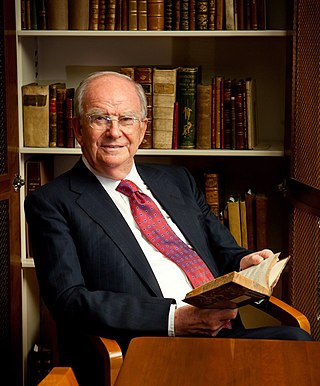
Sir John Meurig Thomas, also known as JMT, was a Welsh scientist, educator, university administrator, and historian of science primarily known for his work on heterogeneous catalysis, solid-state chemistry, and surface and materials science.
Hatten Schuyler Yoder, Jr., was a geophysicist and experimental petrologist who conducted pioneering work on minerals under high pressure and temperature. He was noted for his study of silicates and igneous rocks.
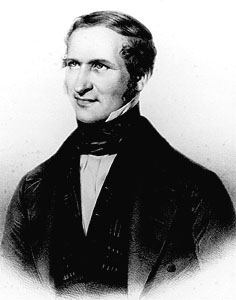
Prof Gustavus ("Gustav") Rose FRSFor HFRSE was a German mineralogist who was a native of Berlin. He was President of the German Geological Society from 1863 to 1873.

Robert Miller Hazen is an American mineralogist and astrobiologist. He is a research scientist at the Carnegie Institution of Washington's Geophysical Laboratory and Clarence Robinson Professor of Earth Science at George Mason University, in the United States. Hazen is the Executive Director of the Deep Carbon Observatory.
Herbert Eugene Merwin was an American mineralogist and petrologist.
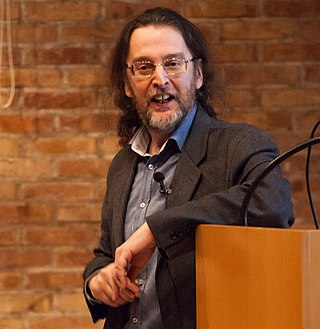
Ross John Angel is an internationally recognized researcher in mineralogy, expert in crystallography and elastic properties of geological materials and key industrial materials, which he studies with experimental and analytical approaches. He is the lead author or co-author of over 240 articles in international scientific journals, he received the Dana Medal from the Mineralogical Society of America in 2011 and is currently a director of research at the Institute of Geosciences and Geo-resources of the National Research Council (Italy).
References
- ↑ Dawson, Barry (2007). "Obituary for Joseph V. Smith" (PDF). Elements. 1: 161.
- 1 2 Wyllie, P.J. (2007). "Joseph V. Smith 1928-2007 (Obituary)" (PDF). Mineralogical Magazine. 71: 113–119. doi:10.1180/S0026461X00007453. S2CID 131389320.
- ↑ "In Memoriam Joe Smith" . Retrieved 14 Jan 2024.
- ↑ "Current NSF-Supported Earth Science Synchrotron Research Organizations". 17 October 2021. Retrieved 14 Jan 2024./
- ↑ Smith, Joseph V. (January 14, 1974). "Feldspar Minerals". SpringerLink. doi:10.1007/978-3-642-96173-1. ISBN 978-3-642-96175-5.
- ↑ Smith, Joseph V. (January 14, 1974). "Feldspar Minerals". SpringerLink. doi:10.1007/978-3-642-65743-6. ISBN 978-3-642-65745-0.
- ↑ "Royal Society Catalogue EC/1978/33".
- ↑ "Joseph V. Smith". www.nasonline.org.
- ↑ "Guide to the Joseph V. Smith Papers 1949-2007". www.lib.uchicago.edu.